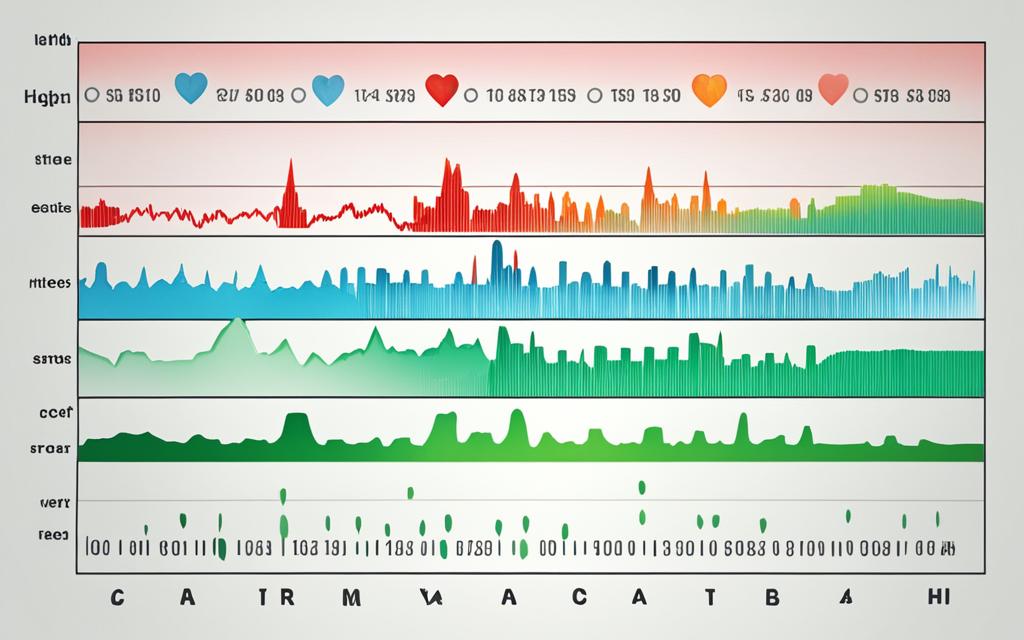Your heart rate is not a constant, metronome-like rhythm. Instead, it varies from one heartbeat to the next, a phenomenon known as heart rate variability (HRV). This natural fluctuation in the time interval between heartbeats is a powerful indicator of your overall health and fitness. HRV reflects your heart’s ability to adapt to various stressors, providing insights into your nervous system function, cardiovascular health, and resilience to stress.
Understanding Heart Rate Variability
Heart rate variability (HRV) is the variation in the time interval between consecutive heartbeats. This variation is controlled by the autonomic nervous system, which regulates many of the body’s involuntary functions, including heart rate, breathing, and digestion. The autonomic nervous system has two main branches: the sympathetic nervous system, which prepares the body for action, and the parasympathetic nervous system, which promotes rest and recovery.
The science behind heart rate variability reveals that this natural fluctuation in your heartbeat is a reflection of your body’s ability to adapt to various stimuli and stressors. When your heart rate variability is high, it indicates that your autonomic nervous system is functioning well, able to respond flexibly to changes in your environment and internal state. Conversely, a low HRV can be a sign of an imbalance in your autonomic nervous system, which may be associated with increased stress, poor cardiovascular health, or other underlying health issues.
By understanding how heart rate variability works, you can gain valuable insights into your overall health and wellbeing. HRV provides a window into the complex interplay between your heart, your brain, and your body’s stress response, allowing you to monitor and optimize your physical and mental resilience.
Factors Affecting Heart Rate Variability
Your heart rate variability (HRV) can be influenced by a variety of factors, including your lifestyle, health, age, and gender. Understanding these factors can provide valuable insights into how to optimize your HRV and support your overall well-being.
Lifestyle factors play a significant role in how your HRV is affected. Things like your physical activity levels, stress management, sleep quality, and dietary choices can all impact the natural fluctuations in your heartbeat. For example, regular exercise has been shown to increase HRV, while chronic stress can lead to a decrease in HRV.
Your overall health status is another crucial factor that can influence your heart rate variability. Conditions like heart disease, diabetes, and obesity have been associated with reduced HRV, as they can impair the autonomic nervous system’s ability to regulate your heart rate.
Interestingly, age and gender also play a role in heart rate variability. As you get older, your HRV tends to decrease, reflecting the natural changes in your autonomic nervous system. Additionally, studies have shown that women generally have higher HRV compared to men, which may be due to hormonal and physiological differences.
| Factor | Impact on HRV |
|---|---|
| Physical Activity | Increased HRV |
| Chronic Stress | Decreased HRV |
| Heart Disease | Decreased HRV |
| Age | Decreased HRV with aging |
| Gender | Women generally have higher HRV than men |
By understanding the various factors affecting heart rate variability, you can take steps to optimize your HRV and support your overall health and well-being. This can involve adopting healthier lifestyle habits, managing stress effectively, and monitoring your HRV over time.
How to Measure Heart Rate Variability
Measuring heart rate variability typically involves using specialized HRV monitoring devices or applications that can detect the subtle variations in the time between each heartbeat. Some common HRV assessment methods include:
- Wearable fitness trackers and smartwatches: These devices, such as Fitbit, Apple Watch, or Garmin, often have built-in HRV monitoring capabilities that can track your heart rate variability throughout the day.
- Smartphone apps: Apps like HRV4Training, Elite HRV, and CorSense can use your smartphone’s camera to measure HRV by detecting small changes in your fingertip’s blood volume.
- Dedicated HRV devices: Devices like ithlete, Polar H10, and Suunto Heart Rate Sensors are designed specifically for measuring heart rate variability with high accuracy.
- Electrocardiogram (ECG) recordings: Medical-grade ECG devices, such as those used in clinical settings, can provide the most precise measurements of HRV by directly recording the electrical activity of the heart.
Regardless of the HRV monitoring device or assessment method you choose, it’s important to follow the manufacturer’s instructions and establish a consistent measurement routine to ensure accurate and reliable heart rate variability data.
| HRV Monitoring Device | Key Features | Accuracy |
|---|---|---|
| Fitbit Charge 5 | Continuous heart rate monitoring, HRV tracking, stress management tools | High accuracy for general fitness tracking |
| Polar H10 Heart Rate Sensor | Chest strap design for precise heart rate and HRV measurement | Clinical-grade accuracy for advanced users |
| Oura Ring | Discreet wearable with heart rate, HRV, and sleep tracking | Moderate accuracy, suitable for general wellness monitoring |
| CorSense HRV Sensor | Smartphone-based HRV measurement with medical-grade precision | High accuracy, comparable to clinical-grade ECG devices |
Heart Rate Variability and Overall Health
Heart rate variability (HRV) is closely tied to your overall health and well-being. A high HRV is generally associated with better health outcomes, as it indicates a well-functioning autonomic nervous system and your heart’s ability to adapt to changing demands. HRV serves as a valuable health indicator, providing insights into the state of your cardiovascular health.
Your heart rate variability reflects the balance between your sympathetic and parasympathetic nervous systems, which are responsible for your body’s stress response and recovery processes. A healthy heart exhibits natural fluctuations in the time between each heartbeat, demonstrating its flexibility and resilience. This HRV and overall health connection is why monitoring your HRV can offer valuable clues about your general wellness and fitness level.
By tracking your HRV, you can gain a deeper understanding of how your lifestyle, stress levels, and various health factors are impacting your cardiovascular health. This information can empower you to make informed decisions about your daily habits, exercise regimen, and overall well-being, ultimately supporting your long-term health and vitality.
| HRV Indicator | Interpretation |
|---|---|
| High HRV | Indicates a well-functioning autonomic nervous system, good cardiovascular health, and resilience to stress. |
| Low HRV | May suggest an imbalance in the autonomic nervous system, increased stress, or underlying health issues. |
By understanding the relationship between HRV as a health indicator and your overall well-being, you can take proactive steps to optimize your health and performance. Regularly monitoring your HRV can provide valuable insights, enabling you to make adjustments to your lifestyle, stress management, and exercise routine to support your long-term health and vitality.
Using Heart Rate Variability to Monitor Stress and Recovery
One of the most significant applications of heart rate variability is its ability to provide insights into your body’s stress response and recovery process. Your HRV reflects the balance between your sympathetic and parasympathetic nervous systems, which are the key players in the stress management process.
When you experience stress, your sympathetic nervous system activates, leading to an increase in heart rate and a decrease in HRV. This is the body’s natural “fight-or-flight” response. However, it’s the recovery process, or the activation of the parasympathetic nervous system, that is crucial for your overall well-being. By using HRV to monitor stress, you can gain valuable information about your body’s ability to recover and adapt to stressful situations.
A high HRV indicates a healthy balance between the two branches of the autonomic nervous system, suggesting that your body is able to effectively manage stress and bounce back from challenging situations. Conversely, a low HRV may be a sign of excessive stress, burnout, or an imbalance in your nervous system.
By regularly monitoring your HRV, you can gain insights into your body’s stress levels and recovery status, enabling you to make more informed decisions about your lifestyle, training, and stress management strategies. This information can be particularly useful for athletes, fitness enthusiasts, and individuals looking to optimize their overall health and well-being.
| Indicators | High HRV | Low HRV |
|---|---|---|
| Stress response | Well-balanced sympathetic and parasympathetic activity | Dominant sympathetic activity, indicating high stress levels |
| Recovery process | Efficient activation of the parasympathetic nervous system, enabling effective recovery | Impaired parasympathetic activity, leading to delayed recovery |
| Overall health and well-being | Optimal cardiovascular health, resilience to stress, and general wellness | Increased risk of chronic stress, burnout, and various health issues |
Applications of Heart Rate Variability in Sports and Fitness
Heart rate variability has become an increasingly valuable tool for athletes, coaches, and fitness enthusiasts looking to optimize their HRV in sports and fitness. By monitoring HRV, individuals can gain insights into their body’s readiness and recovery status, allowing them to make more informed decisions about their using HRV for athletic performance and recovery strategies.
One of the primary applications of HRV in sports and fitness is the ability to track an athlete’s training load and adaptation. By monitoring fluctuations in their HRV, athletes can identify periods of high stress or fatigue, which can indicate the need for reduced training intensity or additional recovery time. This helps them avoid the pitfalls of overtraining and ensures they maintain optimal HRV and training optimization for peak performance.
| HRV Metric | Interpretation | Practical Application |
|---|---|---|
| RMSSD (Root Mean Square of Successive Differences) | Measures parasympathetic (recovery) nervous system activity | Indicates readiness for high-intensity training or competition |
| LF/HF Ratio (Low Frequency/High Frequency Ratio) | Reflects the balance between sympathetic (stress) and parasympathetic (recovery) nervous system activity | Helps identify periods of overtraining or excessive stress |
| pNN50 (Percentage of Successive RR Intervals That Differ by More Than 50 ms) | Measures parasympathetic nervous system activity | Provides insights into an athlete’s recovery and adaptation to training |
In addition to training optimization, HRV can also be used to monitor the effectiveness of recovery strategies, such as sleep, nutrition, and stress management. By tracking their HRV in conjunction with these factors, athletes and fitness enthusiasts can fine-tune their recovery routines and ensure they are adequately prepared for their next training session or competition.
Overall, the applications of HRV in sports and fitness, using HRV for athletic performance, and HRV and training optimization have made it an invaluable tool for those seeking to maximize their physical and mental well-being, as well as their athletic potential.
Conclusion
Heart rate variability is a powerful and versatile tool for understanding your overall health and fitness. By monitoring the natural fluctuations in your heartbeat, you can gain valuable insights into the state of your autonomic nervous system, cardiovascular health, and resilience to stress. Whether you’re an athlete looking to optimize your training, or an individual focused on managing your stress and improving your well-being, understanding your heart rate variability can be a game-changer.
The importance of heart rate variability cannot be overstated, as it serves as a vital indicator of your body’s ability to adapt and respond to various physical and emotional demands. By monitoring your HRV and incorporating it into your health and wellness routines, you can uncover insights that can help you make informed decisions about your lifestyle, training, and stress management strategies.
Embracing the power of HRV and health monitoring can be a transformative experience, empowering you to take control of your well-being and live a healthier, more resilient life. So why not start exploring the benefits of using HRV for wellness today? Your body and mind will thank you for it.










